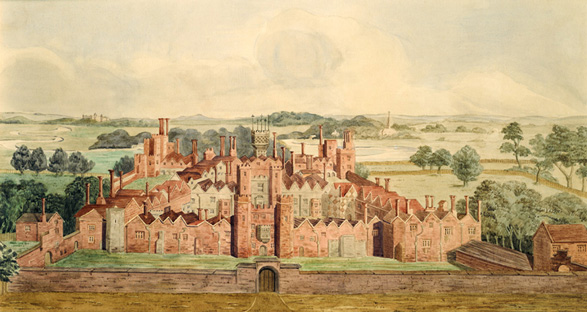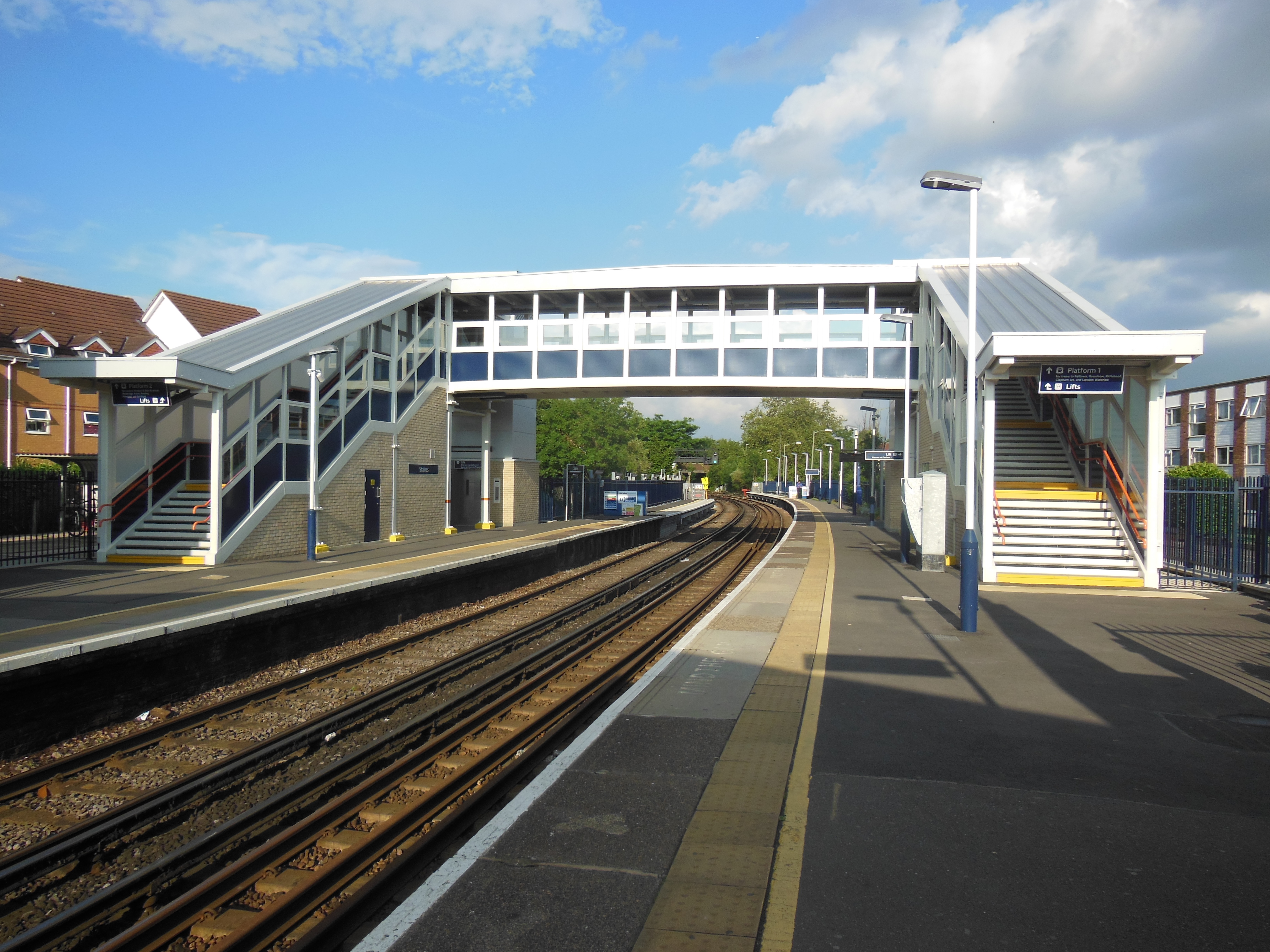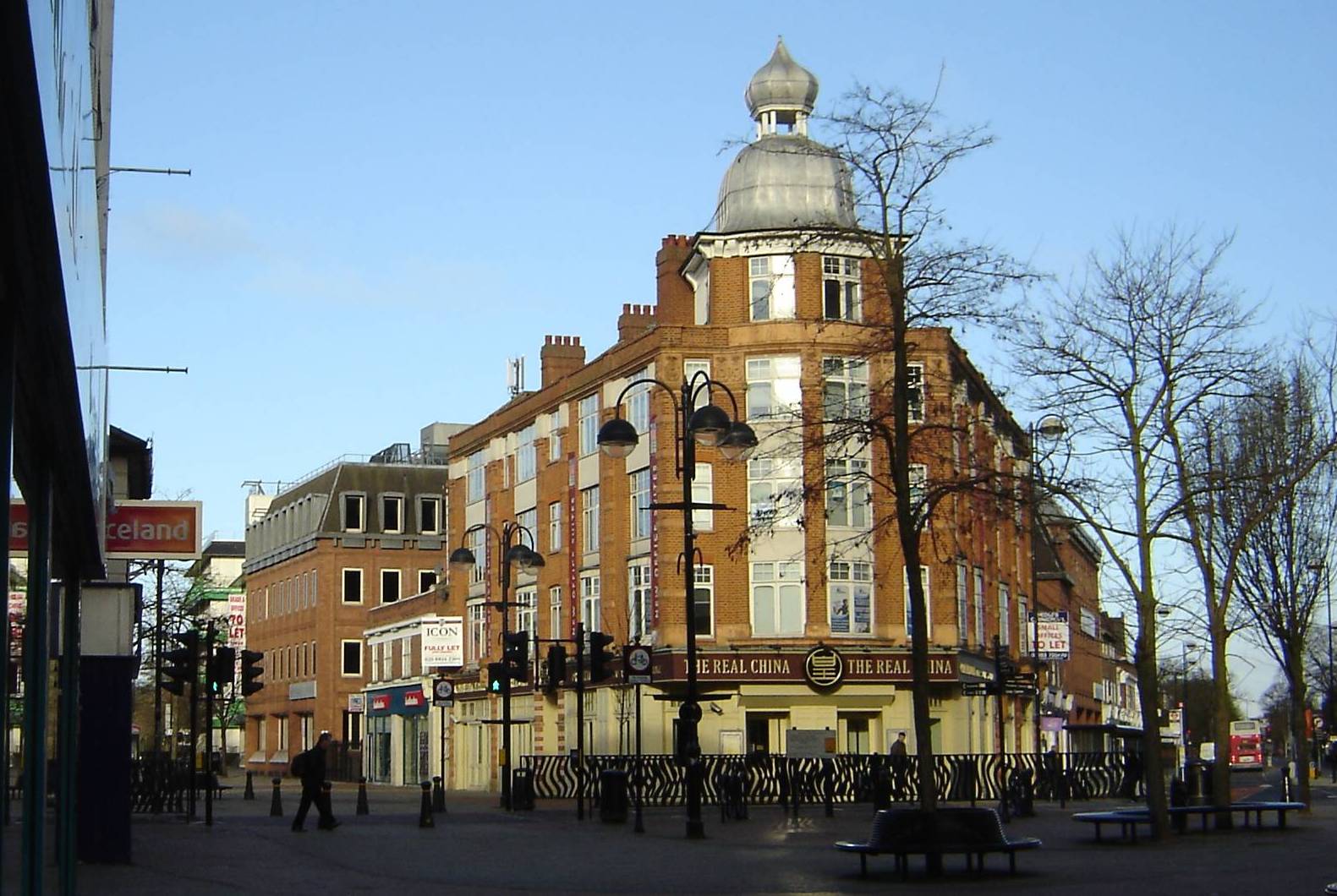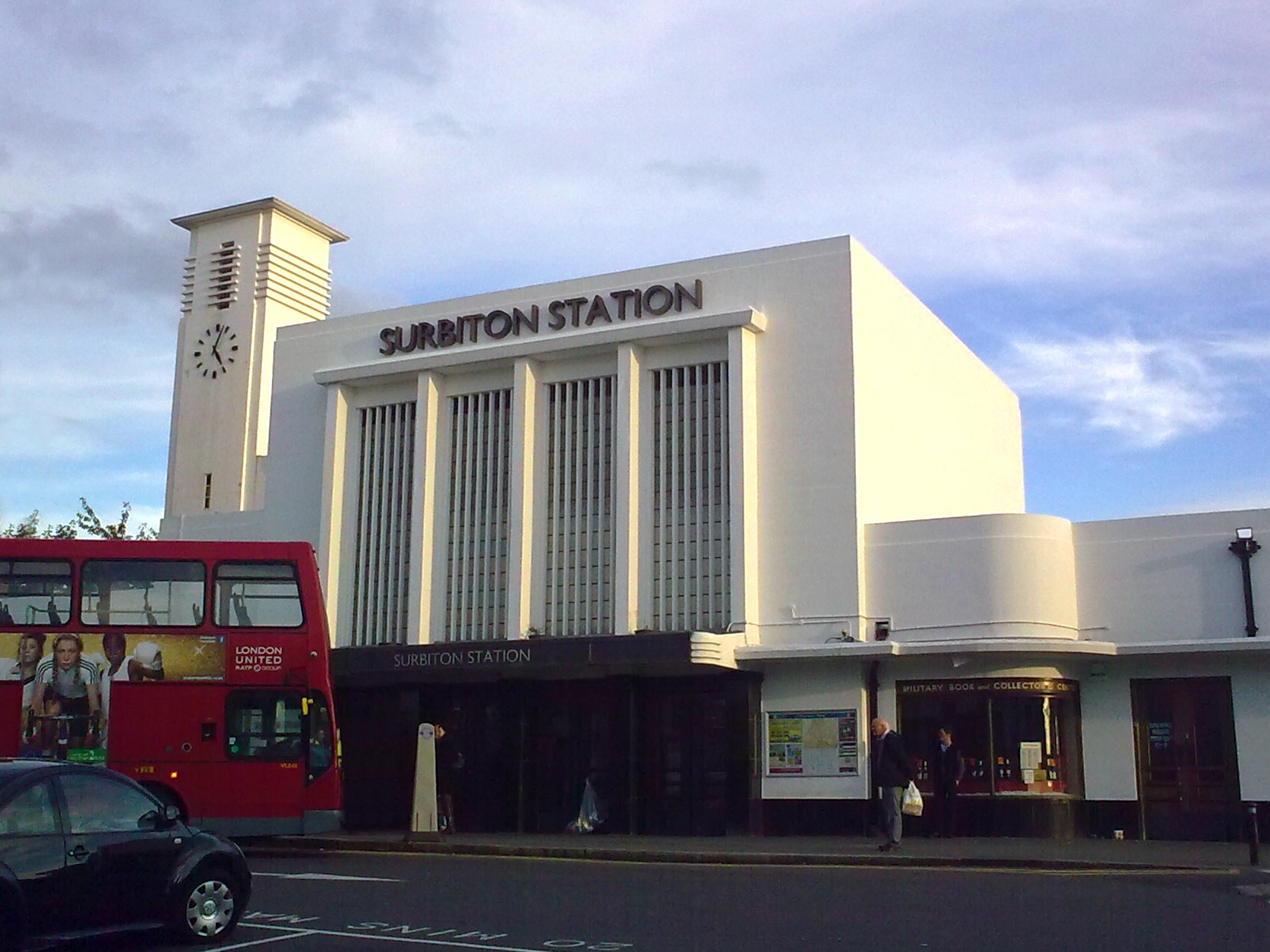|
Weybridge Railway Station
Weybridge railway station is near the established midpoint of Weybridge in Surrey, England and south of its town centre. It is on the South West Main Line and operated by South Western Railway. It is from Railways in the United Kingdom historically are measured in miles and chains. There are 80 chains to one mile. and is situated between and on the main line. The Chertsey branch line diverges from the main line here and runs to . History The station was opened by the London and Southampton Railway on 21 May 1838. The line is set in a deep cutting at this point: the main station buildings are at street level on the Up side of the station and are linked to the platforms by stairs and a footbridge. Up and Down platforms serve the slow lines; there is a bay platform on the up side, from which trains operate on the Chertsey or Weybridge Branch of the Waterloo to Reading Line. Stops on this line include the main towns and villages of Runnymede and it gives Weybridge's longer ro ... [...More Info...] [...Related Items...] OR: [Wikipedia] [Google] [Baidu] |
Weybridge
Weybridge () is a town in the Borough of Elmbridge in Surrey, England, around southwest of central London. The settlement is recorded as ''Waigebrugge'' and ''Weibrugge'' in the 7th century and the name derives from a crossing point of the River Wey, which flows into the River Thames to the north of the town centre. The earliest evidence of human activity is from the Bronze Age. During the Anglo-Saxon and medieval periods, Weybridge was held by Chertsey Abbey. In the 1530s, Henry VIII constructed Oatlands Palace to the north of the town centre, which he intended to be the residence of his fourth wife, Anne of Cleves. He married Catherine Howard there in July 1540 and the palace remained a royal residence until the Civil War. The buildings were demolished in the early 1650s and a new mansion, Oatlands House, was constructed to the east of Weybridge later the same century. Prince Frederick, Duke of York and Albany owned the mansion in the 18th century. The town began to e ... [...More Info...] [...Related Items...] OR: [Wikipedia] [Google] [Baidu] |
Staines Railway Station
Staines railway station is on the Waterloo to Reading line and is the junction station for the diverging Windsor line, in southern England to the west of London. It is down the line from . History The station was opened on 22 August 1848 by the Windsor, Staines and South Western Railway, as part of its line from Richmond to . The line was further extended from Datchet to on 1 December 1849, by which time the Windsor, Staines and South Western Railway had become part of the London and South Western Railway (LSWR). The junction at Staines, together with the line to was authorised in 1853 and built by the Staines, Wokingham and Woking Junction Railway, opening as far as on 4 June 1856 and onwards to Wokingham on 9 July 1856. From the outset, the line was leased to, and operated by, the LSWR, who purchased it outright in 1878. From Wokingham, LSWR trains continued to using running powers over the South Eastern Railway (SER).Mitchell, Vic and Smith, Keith (1989) Branch l ... [...More Info...] [...Related Items...] OR: [Wikipedia] [Google] [Baidu] |
Brooklands
Brooklands was a Auto racing, motor racing circuit and aerodrome built near Weybridge in Surrey, England, United Kingdom. It opened in 1907 and was the world's first purpose-built 'banked' motor racing circuit as well as one of Britain's first airfields, which also became Britain's largest aircraft manufacturing centre by 1918, producing military aircraft such as the Vickers Wellington, Wellington and civil airliners like the Vickers Viscount, Viscount and Vickers VC10, VC-10. The circuit hosted its last race in August 1939 and today part of it forms the Brooklands Museum, a major aviation and motoring museum, as well as a venue for vintage car, motorcycle and other transport-related events. History Brooklands motor circuit The Brooklands motor circuit was the brainchild of Hugh F. Locke King, Hugh Fortescue Locke-King, and was the first purpose-built banked motor race circuit in the world. Following the Motor Car Act 1903, Britain was subject to a blanket speed limit on ... [...More Info...] [...Related Items...] OR: [Wikipedia] [Google] [Baidu] |
Saint George's Hill
St George's Hill is a private gated community in Weybridge, Surrey, United Kingdom. The estate has golf and tennis clubs, as well as approximately 420 houses. Land ownership is divided between homes with gardens, belonging to home owners, and the estate roads and verges belonging to its residents' association. The hill first served as a home and leisure location to celebrities and successful entrepreneurs on its division into lots in the 1910s and 1920s when Walter George Tarrant built its first homes. In a survey, most roads in the estate showed an average house sale price of over £5,500,000, with many properties selling for in excess of £15m and a handful selling for between £20m & £30m, meaning it is one of the most expensive and exclusive places to live in the UK and worldwide. History In April 1649, common land on the hill was occupied by a movement known as the Diggers, who began to farm there. The Diggers are often regarded as one of the world's first small-scale exp ... [...More Info...] [...Related Items...] OR: [Wikipedia] [Google] [Baidu] |
Farnborough (Main) Railway Station
Farnborough (Main) railway station is on the South West Main Line and serves the town of Farnborough in Hampshire, England. The station, and all trains serving it, are operated by South Western Railway. It is one of three stations in the town; the others, named Farnborough North and North Camp are both situated on the North Downs Line. The station is usually known as Farnborough (Main) in order to distinguish it from Farnborough North, including by National Rail and South Western Railway, although it is often signposted simply as Farnborough. It is from Railways in the United Kingdom historically are measured in miles and chains. There are 80 chains to one mile. and is situated between and . History Farnborough railway station was opened in 1838 by the London and South Western Railway (then the London and Southampton Railway), on the line from London to Winchfield (then Shapley Heath). The next year, the line was extended to Basingstoke, then the next year it was co ... [...More Info...] [...Related Items...] OR: [Wikipedia] [Google] [Baidu] |
Hounslow Railway Station
Hounslow () is a large suburban district of West London, west-southwest of Charing Cross. It is the administrative centre of the London Borough of Hounslow, and is identified in the London Plan as one of the 12 metropolitan centres in Greater London. It is bounded by Isleworth to the east, Twickenham to its south, Feltham to its west and Southall to its north. Hounslow includes the districts of Hounslow West, Heston, Cranford and Heathrow. Although most of the district lay within the London Borough of Hounslow, some parts fall within the London Borough of Richmond upon Thames and the London Borough of Hillingdon including Heathrow Airport. Most of Hounslow, including its Town Centre, the area south of the railway station and the localities of Lampton and Spring Grove, falls under the TW3 postcode. The TW4 postcode is made up of Hounslow West and parts of Cranford, whilst the TW5 postcode includes Heston and Cranford. Heathrow Airport and parts of Hatton comp ... [...More Info...] [...Related Items...] OR: [Wikipedia] [Google] [Baidu] |
London Waterloo Station
Waterloo station (), also known as London Waterloo, is a central London terminus on the National Rail network in the United Kingdom, in the Waterloo area of the London Borough of Lambeth. It is connected to a London Underground station of the same name and is adjacent to Waterloo East station on the South Eastern Main Line. The station is the terminus of the South West Main Line to via Southampton, the West of England main line to Exeter via , the Portsmouth Direct line to which connects with ferry services to the Isle of Wight, and several commuter services around west and south-west London, Surrey, Hampshire and Berkshire. The station was opened in 1848 by the London and South Western Railway, and it replaced the earlier as it was closer to the West End. It was never designed to be a terminus, as the original intention was to continue the line towards the City of London, and consequently the station developed in a haphazard fashion, leading to difficulty finding t ... [...More Info...] [...Related Items...] OR: [Wikipedia] [Google] [Baidu] |
Woking Railway Station
Woking railway station is a major stop in Woking, England, on the South West Main Line used by many commuters. It is down the line from . The station is managed by South Western Railway, who operate all trains serving it. History The London and Southampton Railway (L&SR) was authorised on 25 July 1834 and construction began in October of that year. The line was built in stages, and the first section, between the London terminus at and "Woking Common", was opened to passengers on 21 May 1838. Woking Common station was built with two platforms linked by a footbridge and a small freight yard was also provided. When it opened, it was surrounded by open heath and was from what is now the village of Old Woking. Nevertheless, it quickly became the railhead for west Surrey and the main entrance was positioned on the south side of the tracks for the convenience of those travelling by stagecoach from Guildford. Construction of Woking town centre, to the north of the station, did not ... [...More Info...] [...Related Items...] OR: [Wikipedia] [Google] [Baidu] |
Chertsey Railway Station
Chertsey railway station serves the town of Chertsey in the Runnymede District of Surrey, England England is a country that is part of the United Kingdom. It shares land borders with Wales to its west and Scotland to its north. The Irish Sea lies northwest and the Celtic Sea to the southwest. It is separated from continental Europe .... It is on the Chertsey Loop Line and is operated by South Western Railway. The first station was opened by the London and South Western Railway, with the initial section of the Chertsey branch line, in 1848. The existing building, now a Grade II listed building, was opened on 1 October 1866. It comprises Up and Down platforms having brick buildings: the main building being on the Down side. There is a level crossing here. The platforms can hold ten carriage trains. Local mythology ascribes the design of the existing station building to William Tite but, in fact, he had stopped all architectural work about 13 years previous ... [...More Info...] [...Related Items...] OR: [Wikipedia] [Google] [Baidu] |
Surbiton Railway Station
Surbiton is a suburban neighbourhood in South West London, within the Royal Borough of Kingston upon Thames (RBK). It is next to the River Thames, southwest of Charing Cross. Surbiton was in the historic county of Surrey and since 1965 it has been in Greater London. Surbiton comprises four of the RBK's wards: Alexandra, Berrylands, St. Mark's, and Surbiton Hill. Founded originally as Kingston-upon-Railway when the area was first developed in the 1840s, Surbiton possesses a mixture of grand 19th-century townhouses, Art Deco courts, and more recent residential blocks blending in with semi-detached 20th-century housing estates. With a population of 45,132 in 2016, it accounts for approximately 25% of the total population of the Royal Borough of Kingston upon Thames. Surbiton extends over an area of . Etymology Though Surbiton only received its current name in 1869, the name is attested as ''Suberton'' in 1179, ''Surbeton'' in 1263, ''Surpeton'' in 1486, and finally ''Surbiton' ... [...More Info...] [...Related Items...] OR: [Wikipedia] [Google] [Baidu] |
London Waterloo Railway Station
Waterloo station (), also known as London Waterloo, is a central London terminus on the National Rail network in the United Kingdom, in the Waterloo area of the London Borough of Lambeth. It is connected to a London Underground station of the same name and is adjacent to Waterloo East station on the South Eastern Main Line. The station is the terminus of the South West Main Line to via Southampton, the West of England main line to Exeter via , the Portsmouth Direct line to which connects with ferry services to the Isle of Wight, and several commuter services around west and south-west London, Surrey, Hampshire and Berkshire. The station was opened in 1848 by the London and South Western Railway, and it replaced the earlier as it was closer to the West End. It was never designed to be a terminus, as the original intention was to continue the line towards the City of London, and consequently the station developed in a haphazard fashion, leading to difficulty finding th ... [...More Info...] [...Related Items...] OR: [Wikipedia] [Google] [Baidu] |







_p141_-_Waterloo_Station_(plan).jpg)